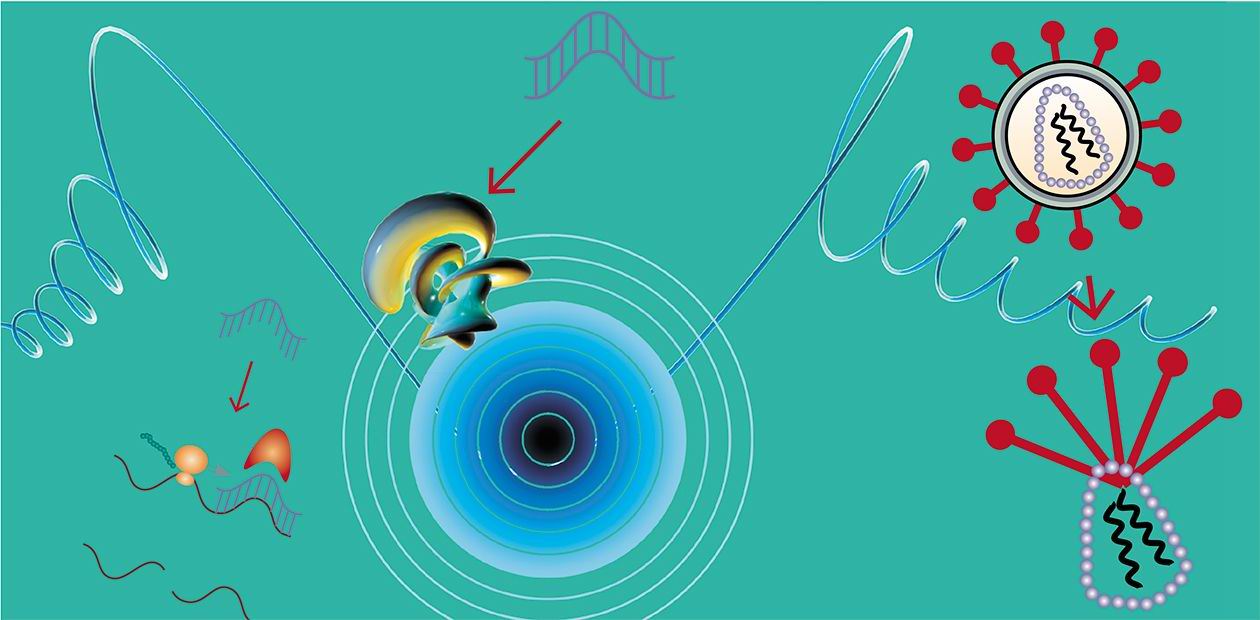Targeting at RNA
The necessary information for the development and organism survival is encoded in its genome. This information is stored in the form of genomic DNA, which contains the sequences encoding for the structure of all proteins of the organism as well as the regulatory elements determining the place, timing and quantity of the proteins to be synthesized. The biologists refer to the sophisticated mechanisms regulating the operation of gene networks as to the system of gene expression
Despite the abundance of reparation, expression control, and innate cell immunity systems, potentially harmful proteins may appear and accumulate in the cell as a result of mutations, disturbed gene expression, or invasion by bacterial or viral pathogens. Those proteins can be the cause of a variety of cell pathologies; thus, the therapeutic approaches based on inactivation of deleterious proteins or shutting down the expression of foreign or mutated genes can cease the infection or mitigate the pathogenic effect of harmful proteins.
The first technological revolution in medicine based on such approaches occurred in the 1970s—1980s with the introduction of monoclonal antibody (mAb) therapies, which were able to selectively bind the cell membrane antigens. By their means it became possible to aim the immune system at a specific target (for example, a malignant cell) or ensure addressed delivery of chemotherapeutic agent or radioactive substance as well as to alleviate the course of a number of autoimmune diseases. The first mAb-based drug designed to prevent graft rejection was clinically approved in 1986, and currently about two dozens of mAb-based therapies are being prescribed.
In case of hereditary diseases resulting from DNA lesions, the principal approach would be the replacement of the damaged genomic DNA fragment with an intact one. In this gene therapy approach sensu stricto, a ”healthy” human gene is introduced into the cells instead of the damaged one by means of a special molecular carrier (vector).
Gene therapy experimentation flourished in the 1990s when it seemed to be almost “at the bedside”, with limited clinical trials in several hospitals. However, an unexpected death of a patient as a result of an unsuccessful gene therapy intervention in 1999, and further cases of post-genotherapeutic complications in 2003 halted the trials.
The complications were associated with insufficient biosafety of viral vectors used for gene therapy. This happened to be a hard blow not only for gene therapy sensu stricto but for all versions of biotherapy, where the modified viruses serve as perfect vehicles for addressed delivery of therapeutic molecules.
The delivery problem is a central issue for possible therapeutic applications of antisense oligonucleotides, ribozymes, and interfering RNAs discussed in this volume (see the publications of E. Chernolovskaya and V. Silnikov).
For a number of disorders—from cardiovascular to oncological—it is the alteration of gene expression that causes the disease. mRNA is the carrier of genetic information from its central storage, the genome, to multiple “protein factories” of the cell, the ribosomes. This role of mRNA as an information carrier makes it the priority target for experimental and therapeutic interventions. Technically, the problem of tracing the specific mRNA in the cellular mRNA pool and its inactivation with the complementary oligonucleotide is a far more achievable task than the inactivation of all protein molecules synthesized on that template with the aid of specific antibodies. The synthesis of antisense oligonucleotides is way cheaper than the manufacture and application of antibodies. The use of complementarity for the regulation of gene expression is the basic principle underlying all versions of antisense technology—from its original version, antisense oligonucleotides, to the ultra-modern RNA interference and triplex technology.
It is the efficiency and accuracy (or the specificity, as the biologist would say) of gene expression shutdown by RNA interference (see the publication of E. Chernolovskaya) that provide a good reason for a number of researchers and medical professionals to consider its possible application for therapy as the most important technological revolution since the introduction of specific monoclonal antibodies.
In this volume we present different scientific and technological approaches to gene expression control at RNA level, cover the history of research schools and pioneer achievements, and discuss the possible applications of modern approaches in therapy and the problems hindering their introduction into clinical practices.














